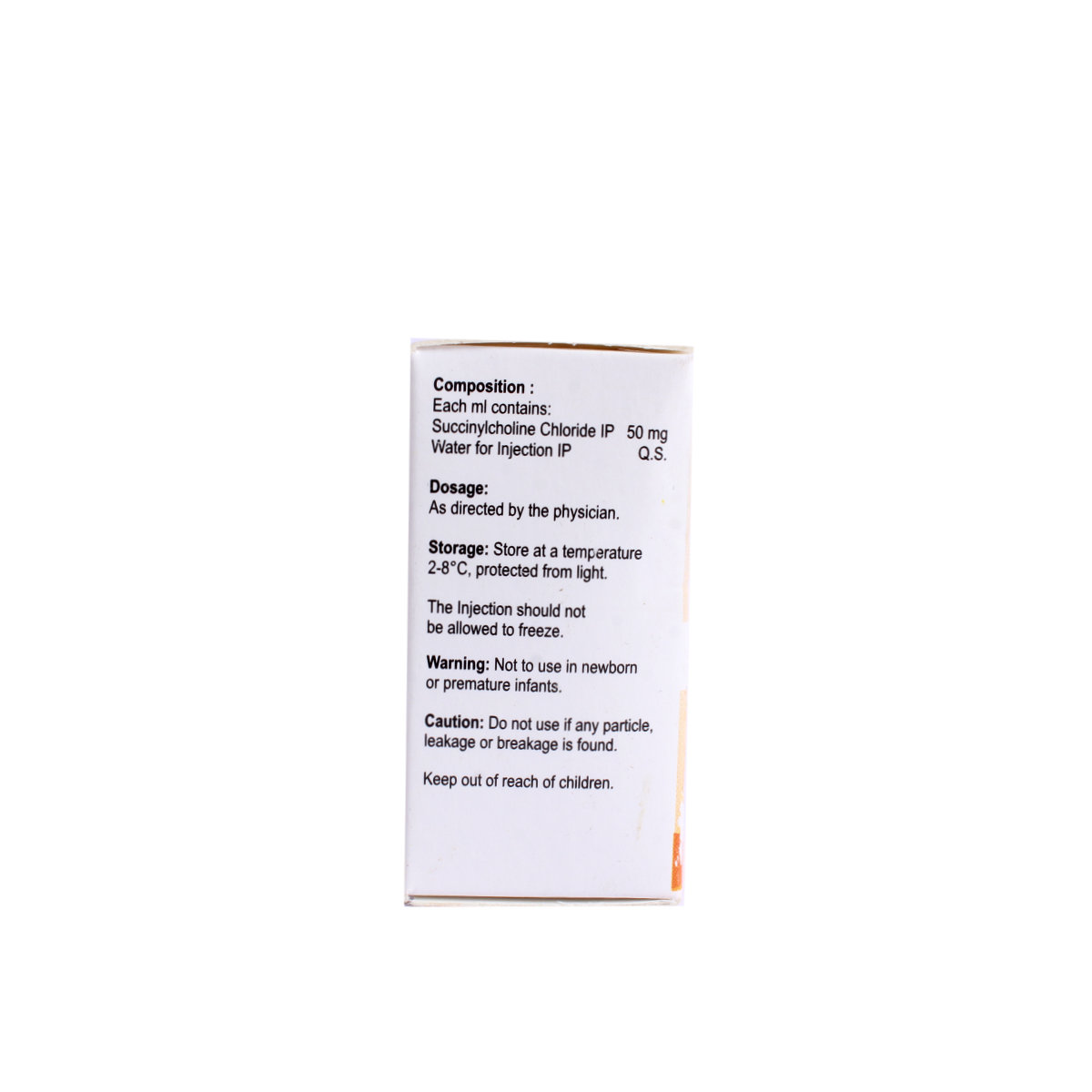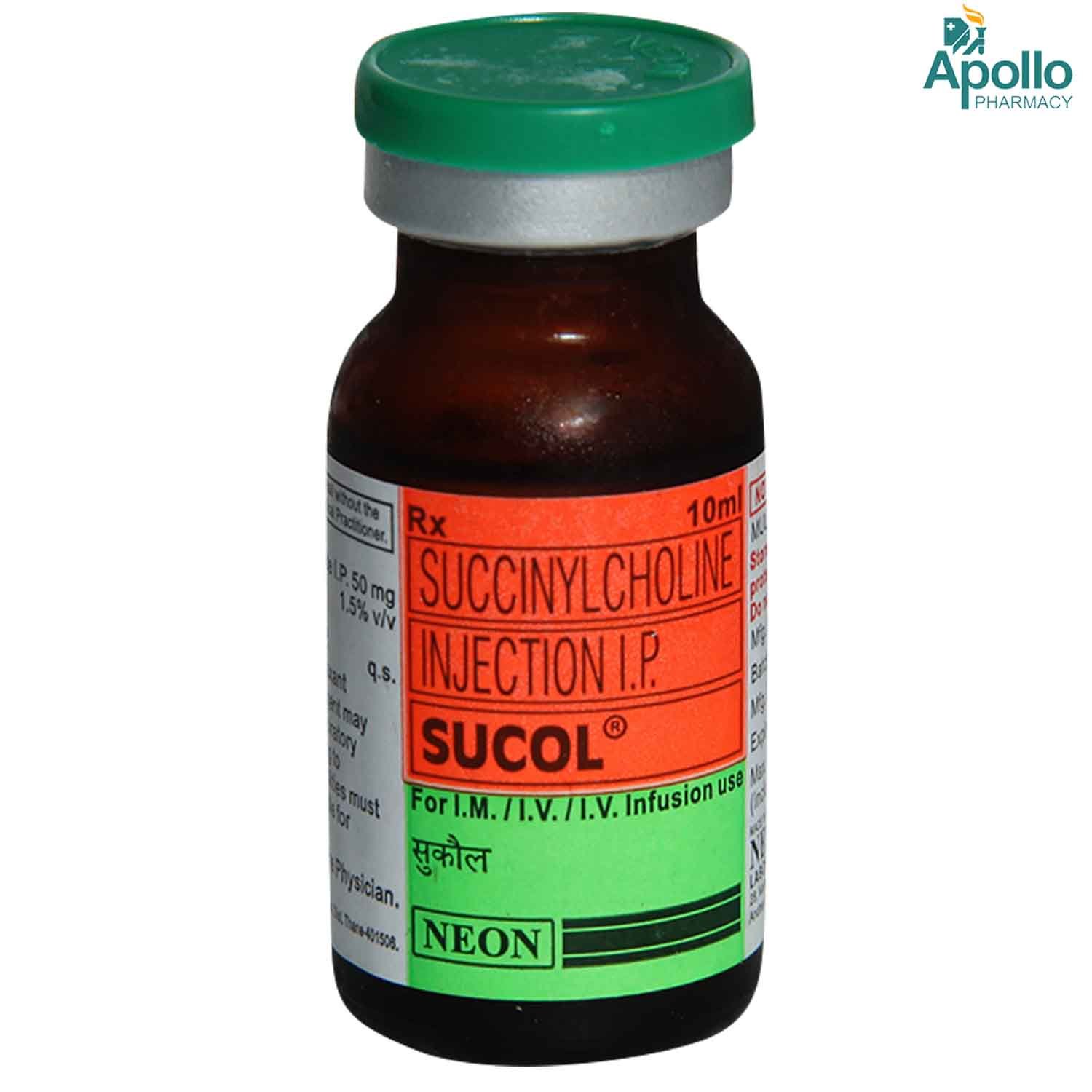Succithem Injection 10 ml
MRP ₹58
(Inclusive of all Taxes)
₹8.7 Cashback (15%)
Provide Delivery Location
Online payment accepted
 Prescription drug
Prescription drugWhats That
Composition :
Manufacturer/Marketer :
Consume Type :
Expires on or after :
Return Policy :
About Succithem Injection
Succithem Injection belongs to the class of medications called muscle relaxants. It is used in supporting general anaesthesia muscle relaxation during intubation. It also reduces the intensity of muscular contractions associated with pharmacologically or electrically induced convulsions.
Succithem Injection contains Succinylcholine Chloride. It relaxes the muscles by blocking the impulses from the nerves.
An experienced clinician or a trained healthcare professional will administer Succithem Injection. Increased intragastric pressure, rash, muscle fasciculation, post-operative muscle pains, myoglobinaemia (acute injury to muscle tissue), transient blood potassium increase, muscle fasciculation (muscle twitch), post-operative muscle pains, intragastric pressure, myoglobinuria (an excess amount of myoglobin in the urine), flushing, bradycardia, tachycardia, increased intraocular pressure, anaphylactic reactions (a severe allergic reaction) are undesirable consequences during your procedure, just like other general anaesthetics, since your anaesthetist will immediately address any issues that emerge during your procedure.
Before taking the Succithem Injection, let your doctor know about all your medical conditions, sensitivities, and medications you are using. Also, inform your doctor if you are pregnant, planning to become pregnant, or breastfeeding.
Uses of Succithem Injection
Directions for Use
Key Benefits
Succithem Injection containes Succinylcholine Chloride, which belongs to the class of drugs known as muscle relaxants. Muscle relaxants are used as part of general anaesthesia during an operation. When undergoing surgery, your muscles must be entirely relaxed. This makes surgery easier for the surgeon. If you are under anaesthesia, Succithem Injection may be used to facilitate the placement of a tube into your trachea (windpipe) for artificial ventilation (mechanical help of breathing). It is also used to reduce the intensity of muscular contractions associated with pharmacologically or electrically induced convulsions.
Storage
Drug Warnings
Succithem Injection should be used with caution in patients who are allergic to muscle relaxants, have had allergies, cardiovascular disease, asthma, pulmonary impairment, burns, hyperkalemia, malignant hyperthermia, skeletal muscle myopathies, and upper motor neuron injury. So, before taking the Succithem Injection, inform your doctor about all of your medical issues, sensitivities, and drugs you are using. Also, let your doctor know if you are pregnant or breastfeeding. Although, the heart muscle is not directly affected by succinylcholine. However, vagal stimulation during surgery or elevated potassium in the blood, particularly in pediatric patients, can also cause changes in heart rate, including cardiac arrest, as Succithem Injection stimulates both autonomic ganglia and muscarinic receptors. Additionally, intraocular pressure rises right after Succithem Injection.
Side Effects of Succithem Injection
- Increased intragastric pressure
- Rash
- Muscle fasciculation
- Post-operative muscle pains
- Myoglobinaemia (acute injury to muscle tissue)
- Transient blood potassium increase
- Muscle fasciculation (muscle twitch)
- Post-operative muscle pains
- Intragastric pressure
- Myoglobinuria (an excess amount of myoglobin in the urine)
- Flushing
- Bradycardia
- Tachycardia
- Increased intraocular pressure
- Anaphylactic reactions (a severe allergic reaction)
Habit Forming
Therapeutic Class
All Substitutes & Brand Comparisons
RX
SUCOL INJECTION 10ML
Neon Laboratories Ltd
₹55.5
(₹5.0/ 1ml)
4% CHEAPER
Author Details
We provide you with authentic, trustworthy and relevant information
FAQs
Disease/Condition Glossary
General anaesthesia: General anaesthesia is a controlled condition of unconsciousness. During general anaesthesia, medications are used to put you to sleep so that you are unaware of the procedure and do not move or experience discomfort. A general anaesthetic is used for surgical operations if it is safer or more pleasant for you to be asleep.
Muscle relaxant: A muscle relaxant is a medication that affects skeletal muscle function and tone. It can help with symptoms like muscle spasms, discomfort, and hyperreflexia. It can also be utilized in Intensive Care Units to relax muscles for certain medical procedures.

Have a query?
Alcohol
Safe if prescribed
Consumption of alcohol is not recommended.
Pregnancy
Consult your doctor
Succithem Injection should be used in pregnant women only if clinically needed, and the benefits outweigh the risks. So, inform your doctor before receiving the Succithem Injection if you are pregnant or planning for pregnancy. Your doctor will prescribe only if the benefits outweigh the risks.
Breast Feeding
Consult your doctor
It is not known whether Succithem Injection passes into breastmilk. Avoid breastfeeding for a certain period after receiving Succithem Injection as per the doctor's instructions.
Driving
Safe if prescribed
Patients should not drive or operate heavy machinery for a certain period of time. When Succinylcholine Chloride is administered as part of a general anaesthetic, you may feel tired, weak, or dizzy for a short period of time. Your anesthesiologist can tell you how long the effects will remain.
Liver
Consult your doctor
Caution should be exercised while using Succithem Injection in patients with liver impairment. So, inform your doctor before receiving the Succithem Injection if you have a liver impairment/disorder history. Your doctor will prescribe only if the benefits outweigh the risks.
Kidney
Consult your doctor
Caution should be exercised while using Succithem Injection in patients with Kidney impairment. So, inform your doctor before receiving the Succithem Injection if you have a Kidney impairment/disorder history. Your doctor will prescribe only if the benefits outweigh the risks.
Children
Safe if prescribed
Please consult your doctor. Your child's doctor will prescribe this medicine if the benefits outweigh the risks.










